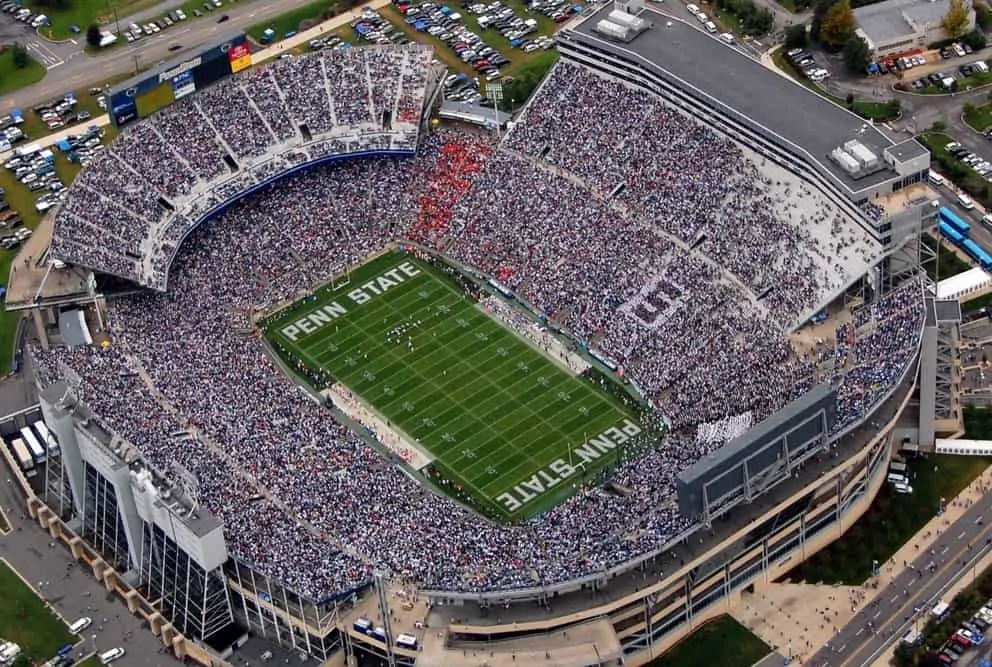

Beaver Stadium
Seating Capacities
- Total Capacity: 72,500
More Information

Beaver Stadium, the home of the Nittany Lions, is one of the nation’s premier football venues. An expansion and renovation prior to the 2001 season added more than 12,000 seats, increasing the stadium’s capacity to 106,572 and easing the waiting list for season ticket requests from Penn State fans.
The second-largest stadium in the nation, the renovation and expansion added rest rooms and concession facilities, new scoreboards with instant-replay capability, and improved handicap access and pedestrian circulation patterns. The most noticeable changes are 60 enclosed skyboxes in a three-level structure above the East stands and an 11,500-seat upper deck in the South end zone.
Beaver Stadium has more than doubled in size since it was moved from its former site northeast of Rec Hall on the west side of campus to the east end of the campus in 1960. The addition of a 10,033-seat upper deck in the north end zone in 1991 and portable seats on the north end zone concourse increased the stadium’s capacity to 93,967.
In 1980, expansion raised the capacity to 83,770. Lights were added in 1984. In 1985, the addition of walkways around the tops of the end zones and entry ramps at the four corners resulted in lowering the capacity to 83,370.
Penn State dedicated Beaver Stadium with a 20-0 win over Boston University on Sept. 17, 1960. Nittany Lion halfback Eddie Caye scored the stadium’s first touchdown at 10:45 of the first quarter.
Built in a horseshoe configuration seating 46,284 in 1960, the stadium now towers 110 rows on the east side, 100 rows on the west, 60 in the lower end zones, 35 in the north upper deck, 20 in the club seating level and 25 in the south upper deck.
Additions of over 2,000 seats in 1969 and more than 9,000 in 1972 increased the capacity to 57,538. Expanded bleachers in the south end zone in 1976 raised the capacity to 60,203.
A uniquely engineered expansion during the winter, spring and summer of 1978 added more than 16,000 seats, bringing the capacity to 76,639. The stadium was cut into sections, raised eight feet by hydraulic jacks and precast concrete seating forms inserted within the inner circle of the stadium, where a running track previously had been located.
Penn State’s first permanent home for football was Beaver Field, which stood between the present-day Osmond and Frear laboratories in center campus. Before that, games were played on the Old Main lawn.
The first game at 500-seat Beaver Field was played on Nov. 6, 1893 against Western University of Pittsburgh (later to become the University of Pittsburgh). The 32-0 Penn State victory was delayed two days because of bad weather and played on a Monday afternoon.
New Beaver Field, located near Rec Hall, was dedicated in 1909 with a 31-0 win over Grove City. Originally constructed of wood, the stadium was converted to steel in 1936. The area also contained facilities for baseball, lacrosse, soccer and track.
New Beaver Field was the Lions’ home through the 1959 season, after which the 30,000-seat stadium was dismantled and moved in 700 pieces one mile to the east side of campus. The old stadium was reassembled with 16,000 additional seats to form Beaver Stadium.
The stadium is named in honor of James A. Beaver. A lawyer in nearby Bellefonte at the outbreak of the Civil War, he enlisted in the Union Army as a second lieutenant and rose to the rank of brigadier general prior to his discharge in 1864. Beaver, who died in 1914, served as a superior court judge, governor of Pennsylvania and president of the University’s Board of Trustees. He is credited with being among the most influential leaders in the development of the University at the turn of the century.
- Box Office:
- Main Offices:
- 2526 Mac Davis Ln, Lubbock, TX 79407
- Contact: Cindy Harper

